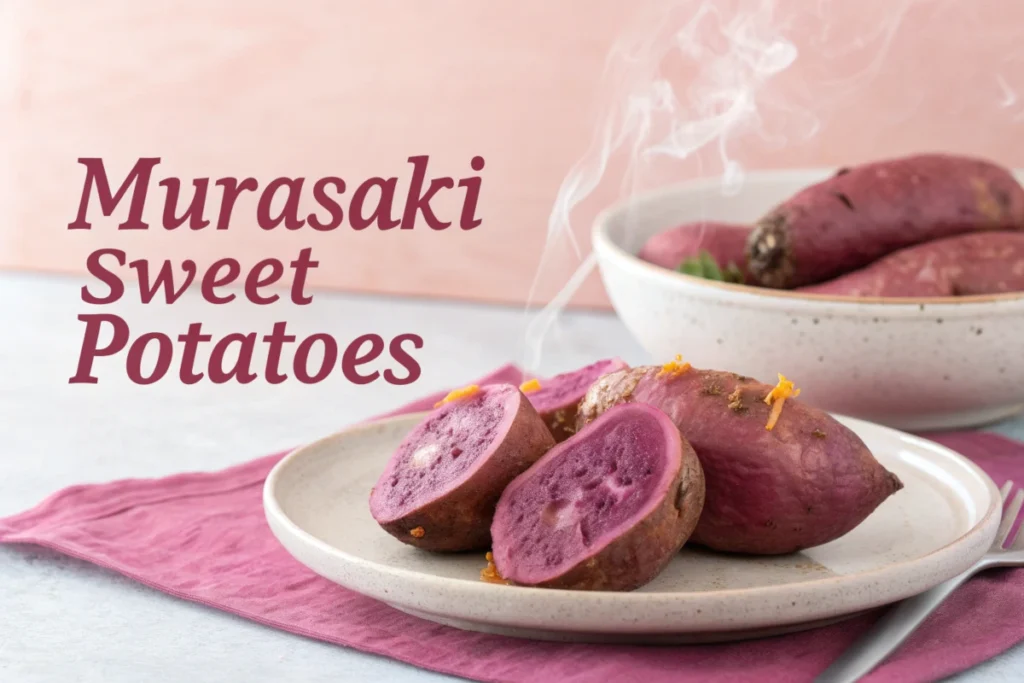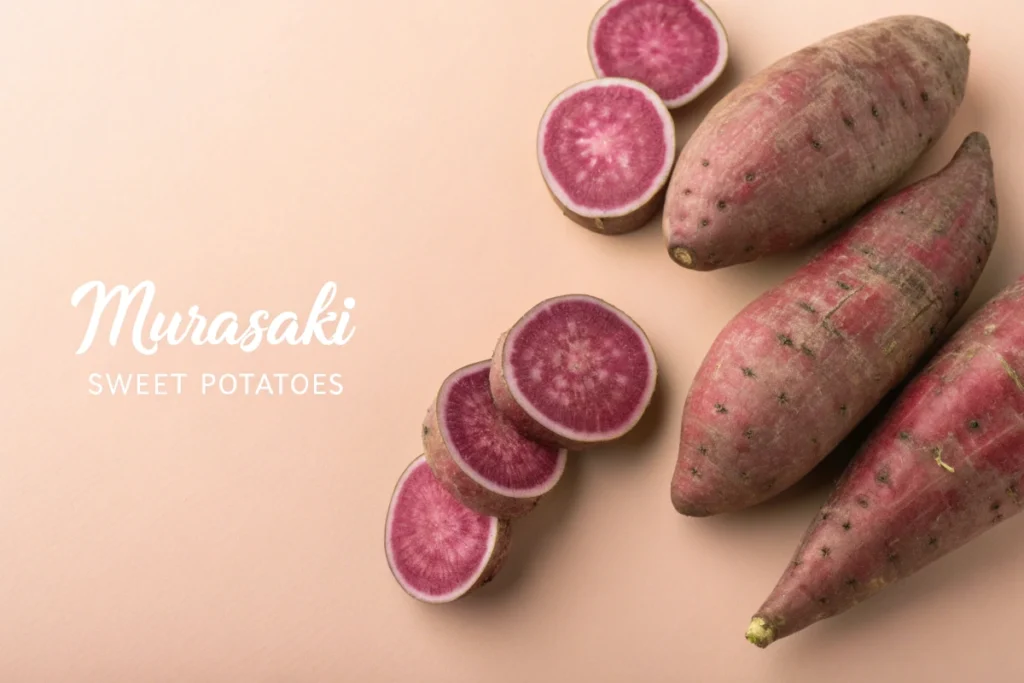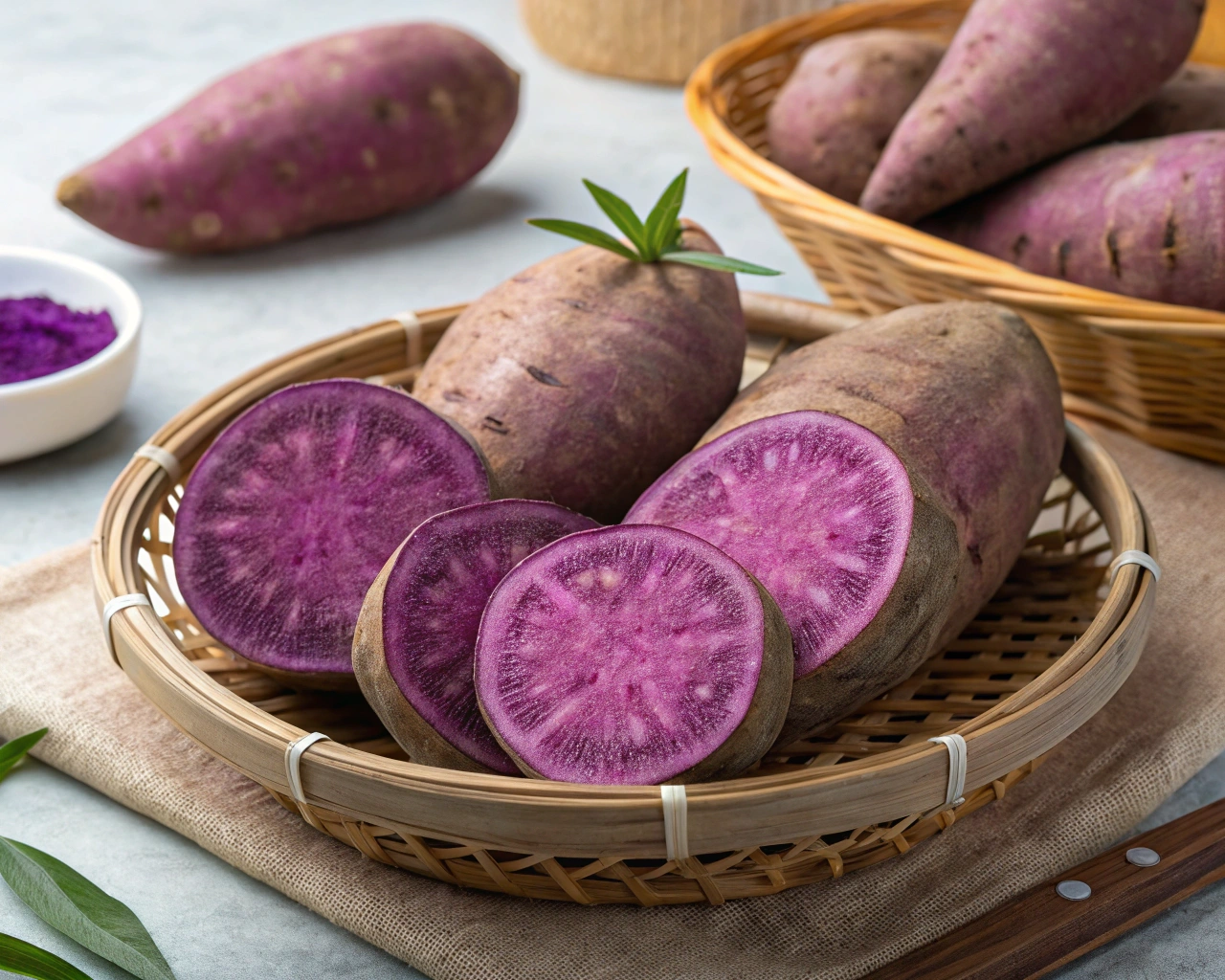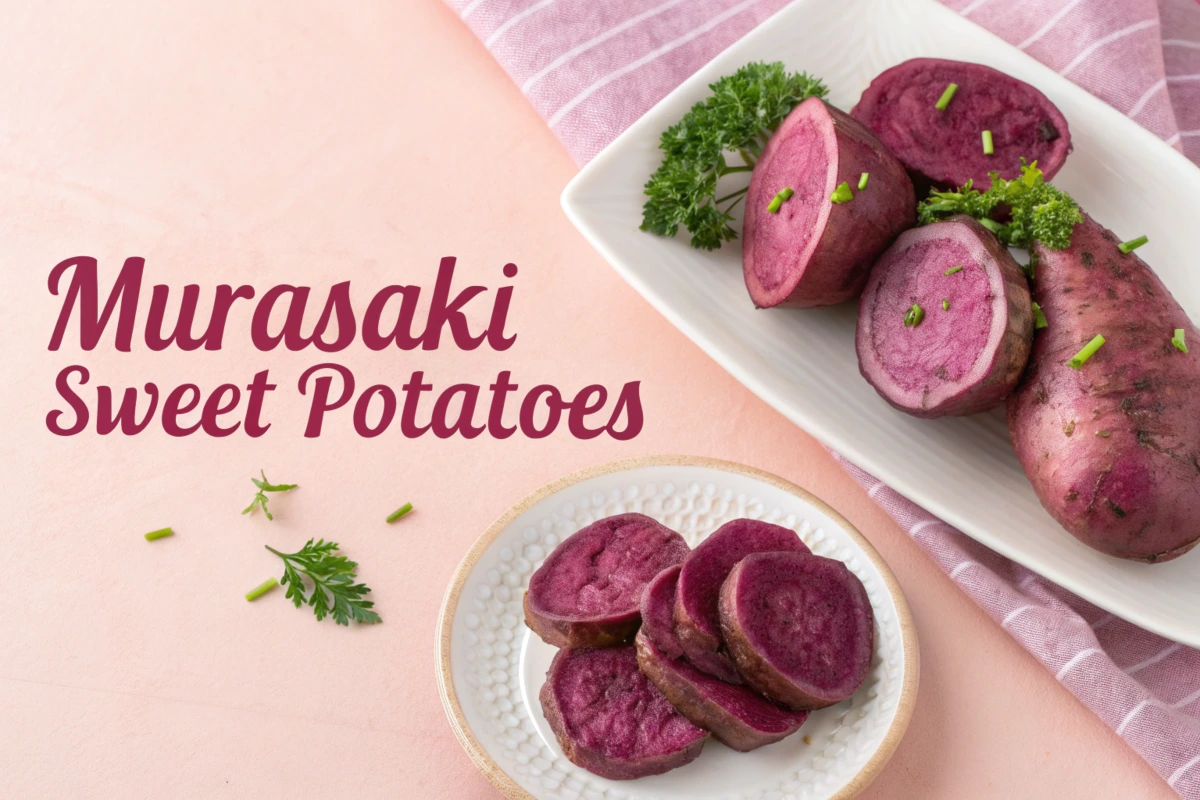What Is Murasaki Sweet Potato?
Murasaki sweet potatoes are known for their striking appearance and unique taste. They are a variety of sweet potatoes with roots in Japan. Their purple skin and creamy white flesh make them visually distinct, while their flavor profile offers a nutty, mildly sweet taste. Let’s explore their origins, history, and distinguishing features to understand what makes them stand out.
Origins and History of Murasaki Sweet Potatoes
The Murasaki sweet potato, also known as the “Japanese purple sweet potato,” originates from Japan. This unique variety became popular for its exceptional flavor, appealing color, and versatility. Its journey to fame didn’t remain limited to Japan, though. This sweet potato later made its way to the United States, thriving particularly in southern states with climates conducive to its growth.
Farmers value this variety for its adaptability to different soils and weather conditions. Its resistance to diseases and pests further contributed to its popularity, making it a go-to crop for sustainable farming. Unlike many other sweet potato varieties, the Murasaki features purple skin, white flesh, and a subtly nutty, earthy flavor, which helps it stand out in global markets.
Distinguishing Features and Characteristics
Murasaki potatoes stand out for their unique appearance and qualities:
- Skin and Flesh: The deep purple skin provides a striking contrast to the creamy white interior, making them visually appealing.
- Taste: Unlike orange-fleshed sweet potatoes, these have a mildly sweet, nutty flavor with a starchy texture.
- Versatility: They work beautifully in both savory and sweet dishes, offering flexibility for chefs and home cooks alike.
- Durability: Known for their long shelf life, Murasaki sweet potatoes can be stored for months if kept in a cool, dry place.
- Health Benefits: Packed with nutrients, they’re an excellent choice for a health-conscious diet (discussed more in the next section).
Nutritional Profile
Key Vitamins and Minerals
Murasaki potatoes are a nutritional powerhouse. They are rich in essential vitamins and minerals, making them a great addition to balanced meals:
- Vitamin A: Boosts vision, immune health, and skin vitality.
- Vitamin C: Helps improve immunity and promotes healthy skin by boosting collagen production.
- Potassium: Supports heart health and muscle function.
- Dietary Fiber: Promotes digestion and keeps you feeling full longer.
- Antioxidants: Protect cells from oxidative stress, potentially lowering the risk of chronic diseases.
Incorporating these into your diet can provide a range of benefits, from better energy levels to improved overall health.
Comparison With Other Sweet Potatoes
Compared to their orange or purple-fleshed cousins, Murasaki sweet potatoes have some notable differences:
- Flavor Profile: While orange sweet potatoes are often sugary, Murasaki ones are nuttier and less sweet.
- Texture: Their starchy and dense texture resembles traditional potatoes, making them excellent for frying or baking.
- Nutrient Content: Although all sweet potatoes are nutritious, Murasaki varieties are particularly high in antioxidants and dietary fiber.
- Culinary Use: Orange sweet potatoes are popular in desserts, while Murasaki varieties are perfect for savory dishes like roasted sides or fries.
When choosing between sweet potato varieties, the Murasaki offers a less sugary, more robust option that suits a range of recipes.

Health Benefits
Rich Source of Antioxidants
Murasaki sweet potatoes are loaded with antioxidants, which play a vital role in maintaining overall health. These compounds help neutralize free radicals in the body, reducing oxidative stress and lowering the risk of chronic diseases such as heart conditions, diabetes, and even some forms of cancer.
One of the key antioxidants in Murasaki sweet potatoes is anthocyanin, which gives the skin its vibrant purple hue. Anthocyanins are known for their anti-inflammatory and immune-boosting properties, making these sweet potatoes an excellent addition to any diet. Regular consumption can also support brain health and slow down age-related cognitive decline.
Benefits for Digestion and Gut Health
These sweet potatoes are a fantastic source of dietary fiber, which is crucial for maintaining a healthy digestive system. Fiber aids in regulating bowel movements, preventing constipation, and ensuring a smooth digestive process.
Moreover, the resistant starch in Murasaki potatoes acts as a prebiotic, feeding beneficial gut bacteria. A balanced gut microbiome improves digestion, enhances immunity, and can even contribute to better mood and mental health. For individuals seeking natural ways to promote gut health, these sweet potatoes are a flavorful and nutritious option.
Cultivation and Harvesting
Ideal Growing Conditions
Murasaki sweet potatoes thrive in warm, sunny climates with well-drained, sandy soil. They are highly adaptable and can grow in different soil types, but ensuring proper drainage is critical to prevent root rot.
Farmers typically plant them in the late spring to early summer, as they require a long growing season of 90 to 120 days. A consistent supply of water during the early stages of growth is necessary, but they are drought-tolerant once established. This resilience makes them a practical crop for sustainable farming.
Seasonal Availability and Harvest Techniques
These sweet potatoes are generally harvested in the late summer to early fall, depending on the planting time and regional climate. Harvesting is a delicate process that involves loosening the soil around the roots to prevent damage.
After harvesting, the potatoes are cured for a week or two at warm temperatures. This curing process enhances their flavor and extends their shelf life. Once cured, they are ready for distribution and storage, ensuring their availability throughout the colder months.
Culinary Uses
Popular Dishes Featuring Murasaki Sweet Potatoes
They are versatile and can be featured in a wide array of dishes, including:
- Roasted Sides: Their nutty flavor shines when simply roasted with olive oil and herbs.
- Sweet Potato Fries: A healthier alternative to traditional fries, offering a unique twist on a classic favorite.
- Soups and Stews: Adds a starchy, creamy texture and earthy flavor to hearty dishes.
- Desserts: While less sweet than orange varieties, they can be used in pies and puddings for a subtly sweet flavor.
These dishes highlight the Murasaki sweet potato’s ability to elevate both simple and complex recipes.
Cooking Methods: Roasted, Mashed, Baked
Cooking Murasaki sweet potatoes is straightforward, and their natural flavor adapts well to many methods:
- Roasting: Slice them into wedges, toss with olive oil, and roast at 400°F for 30 minutes.
- Mashing: Boil until tender, then mash with butter, cream, and seasonings for a creamy side.
- Baking: Wrap them in foil and bake whole at 375°F for an hour until soft.
- Frying: Thinly slice, coat with spices, and fry until crispy for delicious chips.
No matter the method, these sweet potatoes deliver a rich, satisfying flavor and texture.
Storing and Preserving
Tips for Prolonging Freshness
To maximize the shelf life of Murasaki sweet potatoes, follow these simple storage tips:
- Cool, Dark Place: Store them in a well-ventilated area away from direct sunlight and moisture.
- Avoid Refrigeration: Cold temperatures can alter their texture and flavor.
- Inspect Regularly: Check for signs of sprouting or spoilage and remove any affected potatoes.
Under the right conditions, they can stay fresh for several months, making them a convenient pantry staple.
Freezing and Dehydration Methods
For long-term preservation, freezing and dehydration are excellent methods:
- Freezing: Cook and mash the sweet potatoes before freezing them in airtight containers. Alternatively, slice and blanch them before freezing.
- Dehydration: Thinly slice the potatoes and dry them in a dehydrator or oven at a low temperature. Once dehydrated, they can be stored in airtight containers for months.
These techniques ensure you can enjoy the goodness of Murasaki sweet potatoes year-round.
Murasaki Sweet Potato vs. Other Varieties
Flavor Profile Comparison
Murasaki sweet potatoes offer a flavor that truly sets them apart from other varieties. While traditional orange-fleshed sweet potatoes have a distinctly sugary taste, Murasaki sweet potatoes provide a mild sweetness paired with a nutty, earthy undertone. This combination makes them more versatile in savory recipes, unlike the candy-like sweetness of their orange counterparts.
On the other hand, purple sweet potatoes tend to be sweeter than Murasaki, but they lack the distinct starchy texture that the Murasaki variety offers. This starchy profile makes Murasaki potatoes ideal for roasting and frying, where a crispy texture is desired.
Nutritional and Textural Differences
When compared to other varieties, Murasaki sweet potatoes stand out nutritionally and texturally:
- Higher in Fiber: Their white flesh contains a significant amount of dietary fiber, promoting better digestion.
- Moderate Sugar Content: They have less natural sugar than the orange or purple varieties, making them suitable for low-sugar diets.
- Starchy Texture: Their denser, starchier consistency contrasts with the creaminess of orange sweet potatoes and the firmness of purple varieties.
These unique characteristics make Murasaki sweet potatoes a healthful and versatile addition to a wide range of culinary creations.
Murasaki Sweet Potato Recipes
Simple Homemade Recipes
Murasaki sweet potatoes are incredibly easy to prepare at home. Here are a few simple recipes to try:
- Roasted Murasaki Wedges: Cut into wedges, drizzle with olive oil, season with salt and pepper, and roast at 400°F for 30 minutes.
- Murasaki Mash: Boil peeled potatoes until soft, mash with butter and cream, and season to taste for a creamy side dish.
- Sweet Potato Chips: Thinly slice, toss with olive oil, sprinkle with paprika, and bake until crispy.
These recipes are straightforward and highlight the potato’s natural flavor, requiring minimal effort.
Fusion Cuisine and Innovative Uses
Moreover, Murasaki sweet potatoes shine in fusion dishes, blending traditional flavors with modern twists. Here are a few ideas to get you started:
- Japanese-Inspired Curry: Add chunks of Murasaki sweet potatoes to a mild curry for a hearty, flavorful twist.
- Sweet Potato Tacos: Use roasted slices as a taco filling with avocado, salsa, and lime for a delicious fusion experience.
- Dessert Bars: Incorporate mashed Murasaki sweet potatoes into cookie or brownie batter for a unique texture and flavor.
These creative uses showcase the versatility of Murasaki sweet potatoes and demonstrate how they can elevate any meal.

Environmental Impact
Sustainability of Murasaki Sweet Potato Farming
Murasaki sweet potatoes are celebrated for their sustainable farming practices. They thrive in diverse climates and require fewer resources, such as water and pesticides, compared to many other crops. Their natural resistance to pests and diseases reduces the need for chemical treatments, promoting healthier soil and ecosystems.
Furthermore, their ability to grow in less-than-ideal soil makes them a resilient crop, providing farmers with a reliable and eco-friendly option. By choosing Murasaki sweet potatoes, consumers support sustainable agricultural practices.
Supporting Eco-Friendly Practices
To further promote sustainability:
- Buy Locally: Reduces carbon emissions associated with long-distance transportation.
- Opt for Organic: Choose organically grown Murasaki sweet potatoes to avoid supporting pesticide-heavy farming.
- Compost Scraps: Potato peels and scraps can be composted to enrich soil for future crops.
These practices contribute to a healthier planet while enjoying this nutritious vegetable.
Where to Buy Murasaki Sweet Potatoes
Finding Them in Local Markets
Murasaki sweet potatoes are often found in specialty stores, farmers’ markets, and grocery chains with a focus on diverse produce. Seasonal availability usually peaks in the fall, so check with local vendors during this time. Asian markets also frequently carry them, given their origins in Japanese cuisine.
Online Purchasing Tips
If you can’t find Murasaki sweet potatoes locally, online platforms offer a convenient alternative. When purchasing online:
- Choose Reputable Sellers: Look for stores specializing in fresh produce with good customer reviews.
- Consider Bulk Orders: Many online vendors provide discounts for larger quantities.
- Check Shipping Policies: Ensure they use expedited shipping to preserve freshness during transit.
Online shopping opens up access to this unique ingredient, even in areas where it’s harder to find.
Pricing and Availability
Seasonal Price Variations
The cost of Murasaki sweet potatoes varies throughout the year. During peak harvest season (late summer to fall), prices tend to be lower due to increased supply. Conversely, off-season prices can be higher due to limited availability and storage costs.
Value for Money Comparison
Compared to other sweet potato varieties, Murasaki offers excellent value for money. They combine affordability with superior nutritional benefits, long shelf life, and culinary versatility, making them a cost-effective choice for families and food enthusiasts alike.

Murasaki Sweet Potato in Global Cuisines
Traditional Dishes from Asia and Beyond
In Japanese cuisine, Murasaki sweet potatoes are often roasted whole and enjoyed as a simple, healthy snack. They are also mashed and incorporated into desserts like daigaku imo (candied sweet potatoes).
Globally, they feature in a variety of recipes:
- Hawaiian Purple Sweet Potato Pie: A tropical twist on the classic dessert.
- Korean Stews: Adds a hearty, starchy element to flavorful broths.
- American Sweet Potato Fries: A unique take on a comfort food staple.
These diverse uses showcase the global appeal of this versatile vegetable.
Regional Culinary Variations
Regional adaptations highlight the adaptability of Murasaki sweet potatoes:
- Japan: Baked and sprinkled with sesame seeds for a traditional touch.
- United States: Used in gluten-free baking or paired with spicy chili.
- Hawaii: Combined with coconut milk in desserts.
These variations reflect the creativity inspired by this remarkable ingredient.
Tips for Choosing the Best Murasaki Sweet Potatoes
Signs of Freshness
When selecting this sweet potatoes, look for the following signs of freshness:
- Firm Texture: Avoid potatoes that feel soft or have visible bruises.
- Smooth Skin: Check for unblemished, vibrant purple skin without cracks.
- Weight: Heavier potatoes indicate higher water content and better quality.
Avoiding Substandard Produce
To avoid purchasing poor-quality potatoes:
- Watch for Sprouts: Sprouted potatoes may indicate age and diminished quality.
- Check for Mold: Discard any potatoes with visible mold or a sour smell.
- Inspect Storage Conditions: Ensure they’re stored in a cool, dry environment at the store.
These tips will help you bring home the best Murasaki sweet potatoes for your meals.
Fun Facts About Murasaki Sweet Potatoes
Cultural Significance
Murasaki sweet potatoes are more than just a nutritious and delicious food; they carry deep cultural significance. Originating in Japan, they are prized for their vibrant purple skin and creamy white interior. The word “Murasaki” itself means “purple” in Japanese, symbolizing nobility and elegance.
In Japanese tradition, sweet potatoes have long been associated with sustenance and resilience. During times of scarcity, they were a reliable crop that provided essential nutrients. Today, they remain a staple in Japanese households and are celebrated in various festivals, especially during harvest season.
Globally, Murasaki sweet potatoes are gaining popularity for their unique flavor and adaptability, serving as a bridge between tradition and modern cuisine. Their cultural significance makes them more than just a food item—they’re a piece of history on your plate.
Surprising Trivia and Historical Anecdotes
- Introduced to the U.S. Market: Murasaki sweet potatoes were first cultivated in California, inspired by Japanese agricultural practices.
- Natural Resistance: Unlike other sweet potato varieties, Murasaki is naturally resistant to pests, reducing the need for pesticides.
- Longevity Symbolism: In Japan, consuming sweet potatoes is often linked to longevity and health due to their nutrient profile.
- Versatile Dye: The vibrant purple skin has been used historically to create natural dyes for textiles and artwork.
- NASA-Approved: Sweet potatoes, including Murasaki, have been studied as a potential food source for space missions due to their high nutrient density.
These fascinating facts highlight the multifaceted appeal of Murasaki sweet potatoes, from their agricultural significance to their role in history and innovation.

FAQs
1. What makes Murasaki sweet potatoes different from other varieties?
Murasaki sweet potatoes are known for their purple skin and white flesh. They are less sweet but starchier than orange varieties, making them ideal for savory dishes. Their nutty flavor and lower sugar content distinguish them from other sweet potatoes.
2. How can I cook Murasaki potatoes for the best flavor?
To bring out their natural flavor, try roasting them at 400°F with a drizzle of olive oil. Other popular methods include baking, mashing, or frying. For a unique twist, incorporate them into stews or curries.
3. Are Murasaki sweet potatoes healthy?
Absolutely! They are rich in dietary fiber, vitamins A and C, and antioxidants. Their starchy composition makes them a great energy source, while their fiber supports digestion and gut health.
4. Can I grow Murasaki sweet potatoes at home?
Yes, they are relatively easy to cultivate. Ensure well-draining soil, warm temperatures, and plenty of sunlight. Plant slips rather than seeds, as sweet potatoes grow best from cuttings.
5. Are Murasaki sweet potatoes suitable for people with diabetes?
Murasaki potatoes have a moderate glycemic index, making them a better option for people with diabetes compared to regular potatoes or high-sugar varieties. However, portion control is still essential.
6. How should I store Murasaki sweet potatoes to keep them fresh?
Store them in a cool, dry place away from sunlight. Avoid refrigerating, as cold temperatures can alter their texture and flavor. For longer storage, consider freezing cooked Murasaki sweet potatoes.
Conclusion
Murasaki sweet potatoes are a culinary treasure, offering a unique flavor, vibrant appearance, and exceptional health benefits. Their nutty taste, starchy texture, and versatility in both savory and sweet dishes set them apart. These potatoes pack essential nutrients and antioxidants, promoting better digestion, increased energy, and overall well-being. If you’re looking for other nutrient-packed ingredients, explore our Healthy Cottage Cheese Recipes.
Murasaki sweet potatoes blend tradition and innovation, thanks to their rich cultural history and sustainable farming practices. Whether you roast, mash, or incorporate them into fusion recipes, they add a distinctive touch to your meals. For more culinary inspiration, check out our Chicken Shrimp Recipes.
Why not include Murasaki sweet potatoes in your next meal? Their versatility and nutritional benefits make them an excellent addition to any diet. Whether you’re exploring global cuisines or looking for a healthier alternative to traditional potatoes, Murasaki sweet potatoes deliver on every front. You can pair them with our Quick Dinner Ideas for 2 for a satisfying meal.
Head to your local market or place an online order to experience the deliciousness of this remarkable ingredient. Your taste buds—and your health—will thank you!


1 thought on “The Marvel of Murasaki Sweet Potato: A Delicious and Nutritious Superfood”